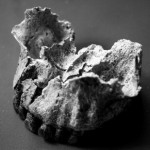 |
OH 65 |
3780 |
|
82 - 64 |
MAX
, TOOTH |
1995 |
127 - National Natural History Museum, Arusha, Tanzania |
I |
Middle/Upper |
|
Blumenschine, R. J., Peters, C. R., Masao, F. T., et al. 2003. Late Pliocene Homo and Hominid Land Use from Western Olduvai Gorge, Tanzania. Science 299, 1217-1221. |
Author describes specimen as "complete maxilla with all teeth and lower face of adult".�Specimen is pictured in images 1-11. (Images from R. Clarke 2011). |
|
|
|
Yes |
|
Mammalia |
Primates |
Anthropoidea |
Haplorhini |
Hominoidea |
Hominidae |
Homininae |
Hominini |
Homo |
habilis |
|
Large habilis |
No |
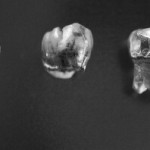 |
OH 66 |
3781 |
7 - FLK North |
|
R-P |
1998 |
127 - National Natural History Museum, Arusha, Tanzania |
I |
Upper |
Surface. |
|
Tooth is lower P4. Specimen is pictured on the far right in image 1. Specimen is pictured in bottom left in image 2. |
|
|
|
No |
|
Mammalia |
Primates |
Anthropoidea |
Haplorhini |
Hominoidea |
Hominidae |
|
|
Australopithecus |
boisei |
|
|
No |
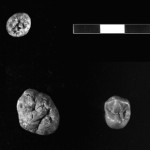 |
OH 67 |
3782 |
14 - HWK E |
|
M-f |
2001 |
127 - National Natural History Museum, Arusha, Tanzania |
II |
Lowermost |
Surface. |
|
Upper adult fragment. Specimen is pictured on top right in image 1. |
|
|
|
No |
|
Mammalia |
Primates |
Anthropoidea |
Haplorhini |
Hominoidea |
Hominidae |
|
|
|
|
|
Homo or Australopithecus |
No |
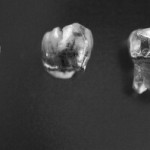 |
OH 68 |
3783 |
18 - VEK |
|
Mand-f, R-P-f |
2001 |
127 - National Natural History Museum, Arusha, Tanzania |
II |
Lower |
|
|
Mandible fragment with unerupted P4 and root of M1.�Specimen is pictured in the middle in image 1.�Specimen is shown in the middle of the top row in image 2. |
|
|
|
Yes |
|
Mammalia |
Primates |
Anthropoidea |
Haplorhini |
Hominoidea |
Hominidae |
|
|
Australopithecus |
africanus |
|
OH 13-like |
No |
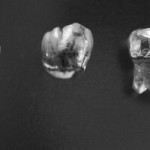 |
OH 69 |
3784 |
80 - MCK |
|
L-P |
2002 |
127 - National Natural History Museum, Arusha, Tanzania |
II |
Lower |
|
|
Lower P4.�Specimen is pictured on left in image 1.�Specimen is pictured on left in image 2. |
|
|
|
Yes |
|
Mammalia |
Primates |
Anthropoidea |
Haplorhini |
Hominoidea |
Hominidae |
Homininae |
Hominini |
Homo |
habilis |
sunsu lato |
|
No |
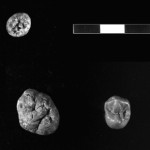 |
OH 70 |
3785 |
80 - MCK |
|
L-M-f |
2002 |
127 - National Natural History Museum, Arusha, Tanzania |
II |
Lower |
|
|
Distrobuccal portion of upper M1 crown.�Specimen is pictured on bottom right of image 1. |
|
|
|
Yes |
|
Mammalia |
Primates |
Anthropoidea |
Haplorhini |
Hominoidea |
Hominidae |
|
|
Australopithecus |
africanus |
|
OH 24-like |
No |
|
OH 71 |
3786 |
24 - DK |
|
TOOTH |
2003 |
127 - National Natural History Museum, Arusha, Tanzania |
I |
Lower |
|
“Discovered by an Earthwatch project led by F.T. Masao in 2003 and 2004, respectively, and will be described elsewhere.” -R. Clarke (2011) |
Specimen is shown. |
|
|
|
Yes |
|
Mammalia |
Primates |
Anthropoidea |
Haplorhini |
Hominoidea |
Hominidae |
|
|
|
|
|
|
No |
|
OH 72 |
3787 |
24 - DK |
|
TOOTH |
2004 |
127 - National Natural History Museum, Arusha, Tanzania |
I |
Lower |
|
“Discovered by an Earthwatch project led by F.T. Masao in 2003 and 2004, respectively, and will be described elsewhere.” -R. Clarke (2011) |
|
|
|
|
Yes |
|
Mammalia |
Primates |
Anthropoidea |
Haplorhini |
Hominoidea |
Hominidae |
|
|
|
|
|
|
No |
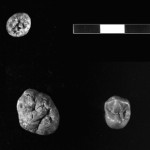 |
OH 73 |
3788 |
81 - HWK W |
|
L-P |
2006 |
127 - National Natural History Museum, Arusha, Tanzania |
I |
Upper |
Surface. |
Clarke, R.J. Published online 4 May 2012. A Homo habilis maxilla and other newly-discovered hominid fossils from Olduvai Gorge, Tanzania.� Olduvai Special issue, JHE |
Left P3.�Specimen is pictured third from the left bottom in image 1.�Specimen is shown on left in image 2. |
|
|
|
No |
|
Mammalia |
Primates |
Anthropoidea |
Haplorhini |
Hominoidea |
Hominidae |
Homininae |
Hominini |
Homo |
habilis |
sensu stricto |
|
No |
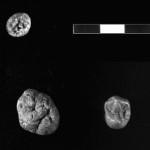 |
OH 74 |
3789 |
72 - FLK Maiko Gully |
|
L-M |
2007 |
127 - National Natural History Museum, Arusha, Tanzania |
I |
ID above |
Surface. |
|
Left M2, unerupted.�Specimen is pictured second from the bottom left in image 1.�Specimen is shown on right in image 2. |
|
|
|
No |
|
Mammalia |
Primates |
Anthropoidea |
Haplorhini |
Hominoidea |
Hominidae |
|
|
Australopithecus� |
boisei |
|
|
No |
|
OH 75 |
3790 |
5 - FLK |
|
R-HUM |
2009 |
127 - National Natural History Museum, Arusha, Tanzania |
I |
Zinjanthropus |
Surface. |
OLAPP/Earthwatch”Discovered by an Earthwatch project led by F.T. Masao in 2003 and 2004, respectively, and will be described elsewhere.” -R. Clarke (2011) |
|
|
|
|
No |
|
Mammalia |
Primates |
Anthropoidea |
Haplorhini |
Hominoidea |
hominidae |
|
|
|
|
|
A. cf. africanus/H. habilis�OH 62-like |
No |
|
OH 76 |
3791 |
55 - FLK W |
|
R-M |
2010 |
127 - National Natural History Museum, Arusha, Tanzania |
II |
Upper? |
Surface. |
“Discovered by an Earthwatch project led by F.T. Masao in 2003 and 2004, respectively, and will be described elsewhere.” -R. Clarke (2011) |
Right upper M1 with roots. |
|
|
|
No |
|
Mammalia |
Primates |
Anthropoidea |
Haplorhini |
Hominoidea |
Hominidae |
|
|
|
|
|
|
No |
|
OH 77 |
3792 |
14 - HWK E |
|
L-M-f |
2010 |
127 - National Natural History Museum, Arusha, Tanzania |
II |
Lowermost |
Surface. |
OLAPP/Earthwatch”Discovered by an Earthwatch project led by F.T. Masao in 2003 and 2004, respectively, and will be described elsewhere.” -R. Clarke (2011) |
Left upper M2 crown. |
|
|
|
No |
|
Mammalia |
Primates |
Anthropoidea |
Haplorhini |
Hominoidea |
Hominidae |
|
|
Australopithecus |
africanus |
|
|
No |
|
OH 78 |
3793 |
10 - BK |
|
H-f |
2007 |
127 - National Natural History Museum, Arusha, Tanzania |
II |
Lower-Middle? |
Surface. |
OLAPP/Earthwatch”Discovered by an Earthwatch project led by F.T. Masao in 2003 and 2004, respectively, and will be described elsewhere.” -R. Clarke (2011) |
Humerus shaft, subaerial weathering. |
|
|
|
No |
|
Mammalia |
Primates |
Anthropoidea |
Haplorhini |
Hominoidea |
Hominidae |
|
|
Australopithecus |
africanus |
|
OH 75-like |
No |
|
OH 79 |
3794 |
49 - BK E |
|
CRA-f |
2007 |
127 - National Natural History Museum, Arusha, Tanzania |
II |
Lower-Middle |
Surface. |
OLAPP “Discovered by an Earthwatch project led by F.T. Masao in 2003 and 2004, respectively, and will be described elsewhere.” -R. Clarke (2011)/Earthwatch |
Weathered. |
|
|
|
No |
|
Mammalia |
Primates |
Anthropoidea |
Haplorhini |
Hominoidea |
Hominidae |
|
|
|
|
|
|
No |
|
OH 80 |
3796 |
10 - BK |
|
R/L-P
, L-M
, R/L-I
, L-HUM-f
, R-RAD-f
, R-FEM-f
, TIB-f |
2009 |
122 - National Museum and House of Culture, Dar es Salaam, Tanzania |
II |
4 |
Upper |
Domínguez-Rodrigo M, et al. 2013. First Partial Skeleton of a 1.34-Million-Year-Old Paranthropus boisei from Bed II, Olduvai Gorge, Tanzania. PLoS ONE 8(12): e80347. |
Distal portion of a left humerus diaphysis. Partial right radius with head, proximal metaphysis and partial diaphysis. Right partial femur, diaphysis in three refitting pieces. Tibia midshaft fragment assigned to OH 80 based on close "spatial association, comparable anatomical ruggedness and similar state of preservation to the other OH 80 postcranial fossils" (Dominiguez-Rodrigo et al., 2013). |
|
|
292 - Proyecto Olduvai |
Yes |
|
Mammalia |
Primates |
Anthropoidea |
Haplorhini |
Hominoidea |
Hominidae |
Homininae |
Hominini |
Australopithecus |
boisei |
|
Anatomically modern |
No |
|
OH 1968 |
3797 |
40 - JK |
|
CRA |
1968 |
125 - Germany |
Ndutu |
Lower |
Surface. |
Von Zieten RRR. 2009. Preliminary report on a new Olduvai hominid from 1968: an Anatomically-Modern-Man from Upper Ndutu Bed. Retrieved from http://www1.uni-hamburg.de/ |
Anatomically modern. Complete skull. |
|
|
|
Yes |
|
Mammalia |
Primates |
Anthropoidea |
Haplorhini |
Hominoidea |
Hominidae |
Homininae |
Hominini |
Homo |
sapiens |
|
Anatomically modern |
No |
|
OVPP-Mammalia |
3801 |
83 - FLK NW |
|
AST, (n=33), CAL, (n=73), FEM, (n=272), HUM, (n=186), I, (n=316), M, (n=108), MAN, (n=161), MAX, (n=68), MTP, (n=257), PHX, (n=77), PVG, (n=218), RAD, (n=55), SCP, (n=40), TIB, (n=395), ULNA, (n=76), VER, (n=595) |
|
|
I |
20 |
|
Arcos, S., Sevilla, P., and Fernandez-Jalvo, Y. 2010. Preliminary small mammal taphonomy of FLK NW level 20 (Olduvai Gorge, Tanzania). Quarternary Research 74:405-410. |
MNI is 198. Authors describe specimens as "small mammals". |
|
|
|
Unknown |
|
Mammalia |
|
|
|
|
|
|
|
|
� |
|
Authors describe specimens as "small mammals". |
No |
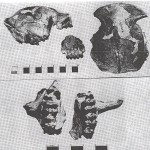 |
MLK 068/6514 |
3803 |
34 - MLK |
|
CRA-f, P, M, (n=3) |
|
|
II |
Lower |
From horizon above Lemuta Member of Lowed Bed II |
Leakey MG and Leakey REF. 1973. New large Pleistocene colobinae (Mammalia, Primates) from East Africa. Fossil Vertebrates of Africa Vol. 3, 121-38. |
Similar to colobine specimen KNM-ER 398 in cranial dimensions. �Maxillary dentition represented by P4, M2, M1, M2. �Crania is represented by multiple fragments, and some fragments are missing. �Large canine socket of right maxilla indicates specimen is male. �Specimen is pictured in Plate 3. � |
|
|
264 - Leakey family expedition |
Unknown |
|
Mammalia |
Primates |
Anthropoidea |
Haplorhini |
Cercopithecoidea |
Cercopithecidae |
|
|
|
|
|
Either Cercopithecinae or Cynopithencinae. Author states that the cranium is typical of Cercopithecinae but that the dental morphology resembles Cynopithecinae. |
No |
|
OVPP-Otomys 4 |
3858 |
6 - FLK NN |
|
CRA-f, M, (n=3) |
|
|
I |
3 |
|
Denys, C. 1989. Phylogenetic affinities of the oldest East African Otomys (Rodentia, Mammalia) from Olduvai Bed I (Pleistocene, Tanzania). Neues Jahrbuch f |
Cranium has left and right upper M123.� |
|
|
|
Unknown |
|
Mammalia |
Rodentia |
Myomorpha |
Myodonta |
Muroidea |
Muridae |
Murinae |
Otomyini |
Otomys |
petteri |
|
|
No |
|
OVPP-Otomys 5 |
3859 |
5 - FLK |
|
MAN-f, (n=41), M, (n=143) |
|
|
I |
|
|
Denys, C. 1989. Phylogenetic affinities of the oldest East African Otomys (Rodentia, Mammalia) from Olduvai Bed I (Pleistocene, Tanzania). Neues Jahrbuch f |
Mandible fragments have M1-M3.�Author states that specimens come from FLKI, FLKNNI layers K, L2, L3, FLKNI layers M1-M6 but does not specify which specimen came from where.�Paper is a systematical study and does not provide specific details about each specimen. |
|
|
|
Unknown |
|
Mammalia |
Rodentia |
Myomorpha |
Myodonta |
Muroidea |
Muridae |
Murinae |
Otomyini |
Otomys |
petteri |
|
|
No |
|
OVPP-Otomys 6 |
3860 |
5 - FLK |
|
MAN-f, (n=78), M, (n=156) |
|
|
I |
|
|
Denys, C. 1989. Phylogenetic affinities of the oldest East African Otomys (Rodentia, Mammalia) from Olduvai Bed I (Pleistocene, Tanzania). Neues Jahrbuch f |
Mandible fragments have M1 and M2.�Author states that specimens come from FLKI, FLKNNI layers K, L2, L3, FLKNI layers M1-M6 but does not specify which specimen came from where.�Paper is a systematical study and does not provide specific details about each specimen. |
|
|
|
Unknown |
|
Mammalia |
Rodentia |
Myomorpha |
Myodonta |
Muroidea |
Muridae |
Murinae |
Otomyini |
Otomys |
petteri |
|
|
No |
|
OVPP-Otomys 7 |
3861 |
5 - FLK |
|
MAN-f, (n=4), M, (n=8) |
|
|
I |
|
|
Denys, C. 1989. Phylogenetic affinities of the oldest East African Otomys (Rodentia, Mammalia) from Olduvai Bed I (Pleistocene, Tanzania). Neues Jahrbuch f |
Mandible fragments have M2 and M3.�Author states that specimens come from FLKI, FLKNNI layers K, L2, L3, FLKNI layers M1-M6 but does not specify which specimen came from where.�Paper is a systematical study and does not provide specific details about each specimen. |
|
|
|
Unknown |
|
Mammalia |
Rodentia |
Myomorpha |
Myodonta |
Muroidea |
Muridae |
Murinae |
Otomyini |
Otomys |
petteri |
|
|
No |
|
OVPP-Otomys 8 |
3862 |
5 - FLK |
|
MAN-f, (n=61), M, (n=61) |
|
|
I |
|
|
Denys, C. 1989. Phylogenetic affinities of the oldest East African Otomys (Rodentia, Mammalia) from Olduvai Bed I (Pleistocene, Tanzania). Neues Jahrbuch f |
Mandible fragments have M1.�Author states that specimens come from FLKI, FLKNNI layers K, L2, L3, FLKNI layers M1-M6 but does not specify which specimen came from where.�Paper is a systematical study and does not provide specific details about each specimen. |
|
|
|
Unknown |
|
Mammalia |
Rodentia |
Myomorpha |
Myodonta |
Muroidea |
Muridae |
Murinae |
Otomyini |
Otomys |
petteri |
|
|
No |
|
OVPP-Otomys 9 |
3863 |
5 - FLK |
|
MAN-f, M |
|
|
I |
|
|
Denys, C. 1989. Phylogenetic affinities of the oldest East African Otomys (Rodentia, Mammalia) from Olduvai Bed I (Pleistocene, Tanzania). Neues Jahrbuch f |
Mandible fragment has M2.�Author states that specimens come from FLKI, FLKNNI layers K, L2, L3, FLKNI layers M1-M6 but does not specify which specimen came from where. |
|
|
|
Unknown |
|
Mammalia |
Rodentia |
Myomorpha |
Myodonta |
Muroidea |
Muridae |
Murinae |
Otomyini |
Otomys |
petteri |
|
|
No |
|
OVPP-Otomys 10 |
3864 |
5 - FLK |
|
M, (n=62) |
|
|
I |
|
|
Denys, C. 1989. Phylogenetic affinities of the oldest East African Otomys (Rodentia, Mammalia) from Olduvai Bed I (Pleistocene, Tanzania). Neues Jahrbuch f |
Specimens are lower M1.�Author states that specimens come from FLKI, FLKNNI layers K, L2, L3, FLKNI layers M1-M6 but does not specify which specimen came from where. |
|
|
|
Unknown |
|
Mammalia |
Rodentia |
Myomorpha |
Myodonta |
Muroidea |
Muridae |
Murinae |
Otomyini |
Otomys |
petteri |
|
|
No |
|
OVPP-Otomys 11 |
3865 |
5 - FLK |
|
MAX-f, (n=16), M, (n=48) |
|
|
I |
|
|
Denys, C. 1989. Phylogenetic affinities of the oldest East African Otomys (Rodentia, Mammalia) from Olduvai Bed I (Pleistocene, Tanzania). Neues Jahrbuch f |
Maxillary fragments have M1, M2 and M3.�Author states that specimens come from FLKI, FLKNNI layers K, L2, L3, FLKNI layers M1-M6 but does not specify which specimen came from where. |
|
|
|
Unknown |
|
Mammalia |
Rodentia |
Myomorpha |
Myodonta |
Muroidea |
Muridae |
Murinae |
Otomyini |
Otomys |
petteri |
|
|
No |
|
OVPP-Otomys 12 |
3866 |
5 - FLK |
|
MAX-f, (n=15), M, (n=30) |
|
|
I |
|
|
Denys, C. 1989. Phylogenetic affinities of the oldest East African Otomys (Rodentia, Mammalia) from Olduvai Bed I (Pleistocene, Tanzania). Neues Jahrbuch f |
Maxilla fragments have M1 and M2.�Author states that specimens come from FLKI, FLKNNI layers K, L2, L3, FLKNI layers M1-M6 but does not specify which specimen came from where. |
|
|
|
Unknown |
|
Mammalia |
Rodentia |
Myomorpha |
Myodonta |
Muroidea |
Muridae |
Murinae |
Otomyini |
Otomys |
petteri |
|
|
No |
|
OVPP-Otomys 13 |
3867 |
5 - FLK |
|
MAX-f, (n=12), M, (n=24) |
|
|
I |
|
|
Denys, C. 1989. Phylogenetic affinities of the oldest East African Otomys (Rodentia, Mammalia) from Olduvai Bed I (Pleistocene, Tanzania). Neues Jahrbuch f |
Maxilla fragments have M2 and M3.�Author states that specimens come from FLKI, FLKNNI layers K, L2, L3, FLKNI layers M1-M6 but does not specify which specimen came from where. |
|
|
|
Unknown |
|
Mammalia |
Rodentia |
Myomorpha |
Myodonta |
Muroidea |
Muridae |
Murinae |
Otomyini |
Otomys |
petteri |
|
|
No |
|
OVPP-Otomys 14 |
3868 |
5 - FLK |
|
MAX-f, (n=9), M, (n=9) |
|
|
I |
|
|
Denys, C. 1989. Phylogenetic affinities of the oldest East African Otomys (Rodentia, Mammalia) from Olduvai Bed I (Pleistocene, Tanzania). Neues Jahrbuch f |
Maxilla fragments have M1.�Author states that specimens come from FLKI, FLKNNI layers K, L2, L3, FLKNI layers M1-M6 but does not specify which specimen came from where. |
|
|
|
Unknown |
|
Mammalia |
Rodentia |
Myomorpha |
Myodonta |
Muroidea |
Muridae |
Murinae |
Otomyini |
Otomys |
petteri |
|
|
No |
|
OVPP-Otomys 15 |
3869 |
5 - FLK |
|
MAX-f, (n=22), M, (n=22) |
|
|
I |
|
|
Denys, C. 1989. Phylogenetic affinities of the oldest East African Otomys (Rodentia, Mammalia) from Olduvai Bed I (Pleistocene, Tanzania). Neues Jahrbuch f |
Maxilla fragments have M2.�Author states that specimens come from FLKI, FLKNNI layers K, L2, L3, FLKNI layers M1-M6 but does not specify which specimen came from where. |
|
|
|
Unknown |
|
Mammalia |
Rodentia |
Myomorpha |
Myodonta |
Muroidea |
Muridae |
Murinae |
Otomyini |
Otomys |
petteri |
|
|
No |
|
OVPP-Otomys 16 |
3870 |
5 - FLK |
|
MAX-f, (n=5) |
|
|
I |
|
|
Denys, C. 1989. Phylogenetic affinities of the oldest East African Otomys (Rodentia, Mammalia) from Olduvai Bed I (Pleistocene, Tanzania). Neues Jahrbuch f |
Maxilla fragments have M3.�Author states that specimens come from FLKI, FLKNNI layers K, L2, L3, FLKNI layers M1-M6 but does not specify which specimen came from where. |
|
|
|
Unknown |
|
Mammalia |
Rodentia |
Myomorpha |
Myodonta |
Muroidea |
Muridae |
Murinae |
Otomyini |
Otomys |
petteri |
|
|
No |
|
OVPP-Otomys 17 |
3871 |
5 - FLK |
|
M, (n=28) |
|
|
I |
|
|
Denys, C. 1989. Phylogenetic affinities of the oldest East African Otomys (Rodentia, Mammalia) from Olduvai Bed I (Pleistocene, Tanzania). Neues Jahrbuch f |
Specimens are upper M1.�Author states that specimens come from FLKI, FLKNNI layers K, L2, L3, FLKNI layers M1-M6 but does not specify which specimen came from where. |
|
|
|
Unknown |
|
Mammalia |
Rodentia |
Myomorpha |
Myodonta |
Muroidea |
Muridae |
Murinae |
Otomyini |
Otomys |
petteri |
|
|
No |
|
OVPP-Otomys 18 |
3872 |
5 - FLK |
|
M, (n=26) |
|
|
I |
|
|
Denys, C. 1989. Phylogenetic affinities of the oldest East African Otomys (Rodentia, Mammalia) from Olduvai Bed I (Pleistocene, Tanzania). Neues Jahrbuch f |
Specimens are upper M2.�Author states that specimens come from FLKI, FLKNNI layers K, L2, L3, FLKNI layers M1-M6 but does not specify which specimen came from where. |
|
|
|
Unknown |
|
Mammalia |
Rodentia |
Myomorpha |
Myodonta |
Muroidea |
Muridae |
Murinae |
Otomyini |
Otomys |
petteri |
|
|
No |
|
OVPP-Otomys 19 |
3873 |
5 - FLK |
|
M, (n=71) |
|
|
I |
|
|
Denys, C. 1989. Phylogenetic affinities of the oldest East African Otomys (Rodentia, Mammalia) from Olduvai Bed I (Pleistocene, Tanzania). Neues Jahrbuch f |
Specimens are upper M3.�Author states that specimens come from FLKI, FLKNNI layers K, L2, L3, FLKNI layers M1-M6 but does not specify which specimen came from where. |
|
|
|
Unknown |
|
Mammalia |
Rodentia |
Myomorpha |
Myodonta |
Muroidea |
Muridae |
Murinae |
Otomyini |
Otomys |
petteri |
|
|
No |
|
M18783 |
3874 |
9 - THC |
|
CAR |
|
|
I |
|
|
-- |
All specimens for this paper are thought to be from one individual (MNI = 1). �Each specimen has its own specimen number. �This carpal is a lunate. |
|
|
|
Unknown |
|
Mammalia |
Perissodactyla |
Ceratomorpha |
Selenida |
Chalicotherioidea |
Chalicotheriidae |
Schizotheriinae |
Schizotheriini |
Ancylotherium |
hennigi |
|
|
No |
|
M18785 |
3875 |
9 - THC |
|
CAR |
|
|
I |
|
|
|
All specimens for this paper are thought to be from one individual (MNI = 1). �Each specimen has its own specimen number. �This carpal is a scaphoid. |
|
|
|
Unknown |
|
Mammalia |
Perissodactyla |
Ceratomorpha |
Selenida |
Chalicotherioidea |
Chalicotheriidae |
Schizotheriinae |
Schizotheriini |
Ancylotherium |
hennigi |
|
Shows resemblance to A. pentelicum. |
No |
|
M18784 |
3876 |
9 - THC |
|
CAR |
|
|
I |
|
|
Butler, P. M., 1965. Fossil Mammals of Africa No. 18. East African Miocene and Pleistocene Chalicotheres. Bulletin of the British Museum (Natural History) (Geology), 10: 163-23. |
All specimens for this paper are thought to be from one individual (MNI = 1). �Each specimen has its own specimen number. �This carpal is a cuneiform. |
|
|
|
Unknown |
|
Mammalia |
Perissodactyla |
Ceratomorpha |
Selenida |
Chalicotherioidea |
Chalicotheriidae |
Schizotheriinae |
Schizotheriini |
Ancylotherium |
hennigi |
|
|
No |
|
M18786 |
3877 |
9 - THC |
|
MTC |
|
|
I |
|
|
|
All specimens for this paper are thought to be from one individual (MNI = 1). �Each specimen has its own specimen number. �This is the second metacarpal. |
|
|
|
Unknown |
|
Mammalia |
Perissodactyla |
Ceratomorpha |
Selenida |
Chalicotherioidea |
Chalicotheriidae |
Schizotheriinae |
Schizotheriini |
Ancylotherium |
hennigi |
|
|
No |
|
M18782 |
3878 |
9 - THC |
|
MTC |
|
|
I |
|
|
|
All specimens for this paper are thought to be from one individual (MNI = 1). �Each specimen has its own specimen number. �This is the third metacarpal. |
|
|
|
Unknown |
|
Mammalia |
Perissodactyla |
Ceratomorpha |
Selenida |
Chalicotherioidea |
Chalicotheriidae |
Schizotheriinae |
Schizotheriini |
Ancylotherium |
hennigi |
|
|
No |








